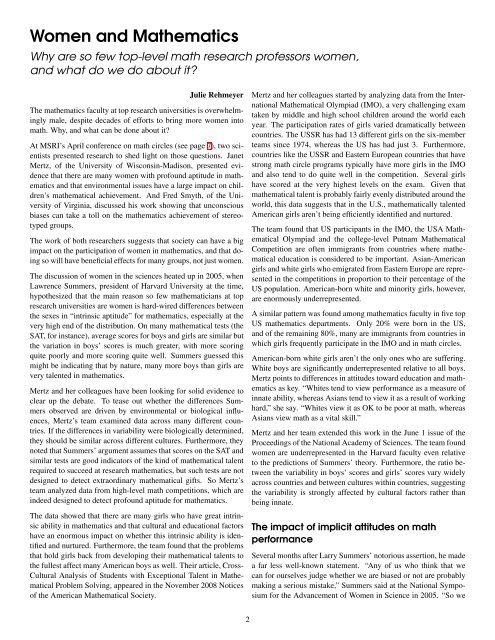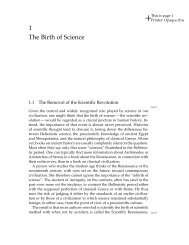Create successful ePaper yourself
Turn your PDF publications into a flip-book with our unique Google optimized e-Paper software.
Women and Mathematics<br />
Why are so few top-level math research professors women,<br />
and what do we do about it?<br />
Julie Rehmeyer<br />
The mathematics faculty at top research universities is overwhelmingly<br />
male, despite decades of efforts to bring more women into<br />
math. Why, and what can be done about it?<br />
At <strong>MSRI</strong>’s April conference on math circles (see page 7), two scientists<br />
presented research to shed light on those questions. Janet<br />
Mertz, of the University of Wisconsin-Madison, presented evidence<br />
that there are many women with profound aptitude in mathematics<br />
and that environmental issues have a large impact on children’s<br />
mathematical achievement. And Fred Smyth, of the University<br />
of Virginia, discussed his work showing that unconscious<br />
biases can take a toll on the mathematics achievement of stereotyped<br />
groups.<br />
The work of both researchers suggests that society can have a big<br />
impact on the participation of women in mathematics, and that doing<br />
so will have beneficial effects for many groups, not just women.<br />
The discussion of women in the sciences heated up in 2005, when<br />
Lawrence Summers, president of Harvard University at the time,<br />
hypothesized that the main reason so few mathematicians at top<br />
research universities are women is hard-wired differences between<br />
the sexes in “intrinsic aptitude” for mathematics, especially at the<br />
very high end of the distribution. On many mathematical tests (the<br />
SAT, for instance), average scores for boys and girls are similar but<br />
the variation in boys’ scores is much greater, with more scoring<br />
quite poorly and more scoring quite well. Summers guessed this<br />
might be indicating that by nature, many more boys than girls are<br />
very talented in mathematics.<br />
Mertz and her colleagues have been looking for solid evidence to<br />
clear up the debate. To tease out whether the differences Summers<br />
observed are driven by environmental or biological influences,<br />
Mertz’s team examined data across many different countries.<br />
If the differences in variability were biologically determined,<br />
they should be similar across different cultures. Furthermore, they<br />
noted that Summers’ argument assumes that scores on the SAT and<br />
similar tests are good indicators of the kind of mathematical talent<br />
required to succeed at research mathematics, but such tests are not<br />
designed to detect extraordinary mathematical gifts. So Mertz’s<br />
team analyzed data from high-level math competitions, which are<br />
indeed designed to detect profound aptitude for mathematics.<br />
The data showed that there are many girls who have great intrinsic<br />
ability in mathematics and that cultural and educational factors<br />
have an enormous impact on whether this intrinsic ability is identified<br />
and nurtured. Furthermore, the team found that the problems<br />
that hold girls back from developing their mathematical talents to<br />
the fullest affect many American boys as well. Their article, Cross-<br />
Cultural Analysis of Students with Exceptional Talent in Mathematical<br />
Problem Solving, appeared in the November 2008 Notices<br />
of the American Mathematical Society.<br />
2<br />
Mertz and her colleagues started by analyzing data from the International<br />
Mathematical Olympiad (IMO), a very challenging exam<br />
taken by middle and high school children around the world each<br />
year. The participation rates of girls varied dramatically between<br />
countries. The USSR has had 13 different girls on the six-member<br />
teams since 1974, whereas the US has had just 3. Furthermore,<br />
countries like the USSR and Eastern European countries that have<br />
strong math circle programs typically have more girls in the IMO<br />
and also tend to do quite well in the competition. Several girls<br />
have scored at the very highest levels on the exam. Given that<br />
mathematical talent is probably fairly evenly distributed around the<br />
world, this data suggests that in the U.S., mathematically talented<br />
American girls aren’t being efficiently identified and nurtured.<br />
The team found that US participants in the IMO, the USA Mathematical<br />
Olympiad and the college-level Putnam Mathematical<br />
Competition are often immigrants from countries where mathematical<br />
education is considered to be important. Asian-American<br />
girls and white girls who emigrated from Eastern Europe are represented<br />
in the competitions in proportion to their percentage of the<br />
US population. American-born white and minority girls, however,<br />
are enormously underrepresented.<br />
A similar pattern was found among mathematics faculty in five top<br />
US mathematics departments. Only 20% were born in the US,<br />
and of the remaining 80%, many are immigrants from countries in<br />
which girls frequently participate in the IMO and in math circles.<br />
American-born white girls aren’t the only ones who are suffering.<br />
White boys are significantly underrepresented relative to all boys.<br />
Mertz points to differences in attitudes toward education and mathematics<br />
as key. “Whites tend to view performance as a measure of<br />
innate ability, whereas Asians tend to view it as a result of working<br />
hard,” she say. “Whites view it as OK to be poor at math, whereas<br />
Asians view math as a vital skill.”<br />
Mertz and her team extended this work in the June 1 issue of the<br />
Proceedings of the National Academy of Sciences. The team found<br />
women are underrepresented in the Harvard faculty even relative<br />
to the predictions of Summers’ theory. Furthermore, the ratio between<br />
the variability in boys’ scores and girls’ scores vary widely<br />
across countries and between cultures within countries, suggesting<br />
the variability is strongly affected by cultural factors rather than<br />
being innate.<br />
The impact of implicit attitudes on math<br />
performance<br />
Several months after Larry Summers’ notorious assertion, he made<br />
a far less well-known statement. “Any of us who think that we<br />
can for ourselves judge whether we are biased or not are probably<br />
making a serious mistake,” Summers said at the National Symposium<br />
for the Advancement of Women in Science in 2005. “So we










